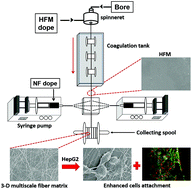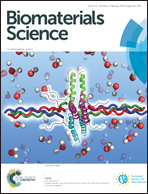Three-dimensional multiscale fiber matrices: development and characterization for increased HepG2 functional maintenance for bio-artificial liver application
Abstract
The development of a cell-growth substrate that provides a nature-like microenvironment, promotes cell adhesion, and maintains the cells’ functional activities is a research focus in the field of tissue engineering. In the present study, three-dimensional micro-nano multiscale fiber-based substrates were developed by depositing biocompatible polycaprolactone (PCL)/PCL-Chitosan (C)/PCL-C-Gelatin (G) electrospun nanofibers (NFs) on the outer surface of hollow fiber membranes (HFMs) in one step. A comparison study with regard to physico-chemical characterization, hemocompatibility, cytotoxicity, and cellular functionality was performed with the developed matrices. The PCL-C-G NFs-deposited HFMs-based matrix showed superior hemocompatibility for blood-contact applications. The cytotoxicity of these matrices was found to be minimal. HepG2 cells exhibited an exceptionally robust adherence and proliferated growth on the matrix with the formation of characteristic multi-cellular spheroids. Furthermore, cell functional activities such as albumin secretion, urea synthesis, and cytochrome P450 specific activity were measured for the developed matrices. The developed three-dimensional multiscale fibers-based matrix can be a potential membrane for bioreactor and bio-artificial liver applications.



 Please wait while we load your content...
Please wait while we load your content...